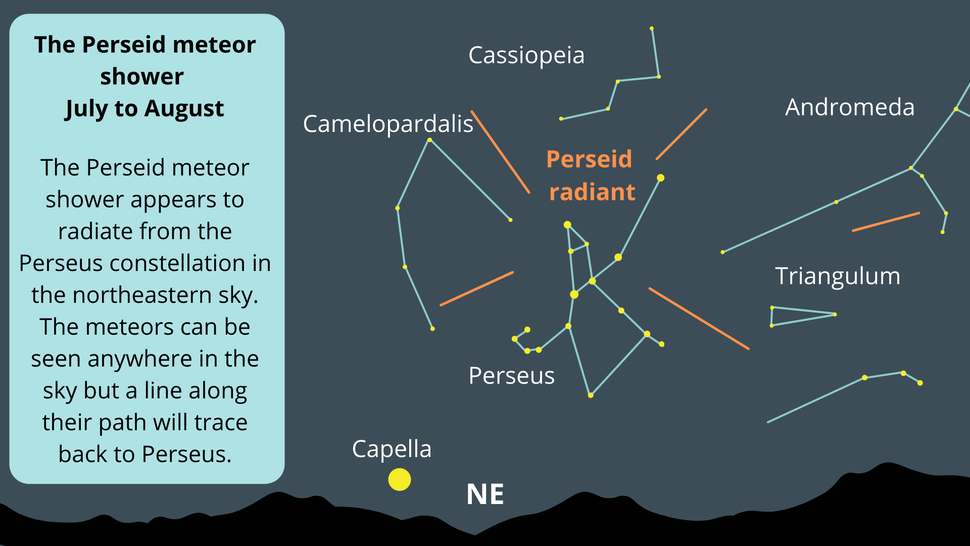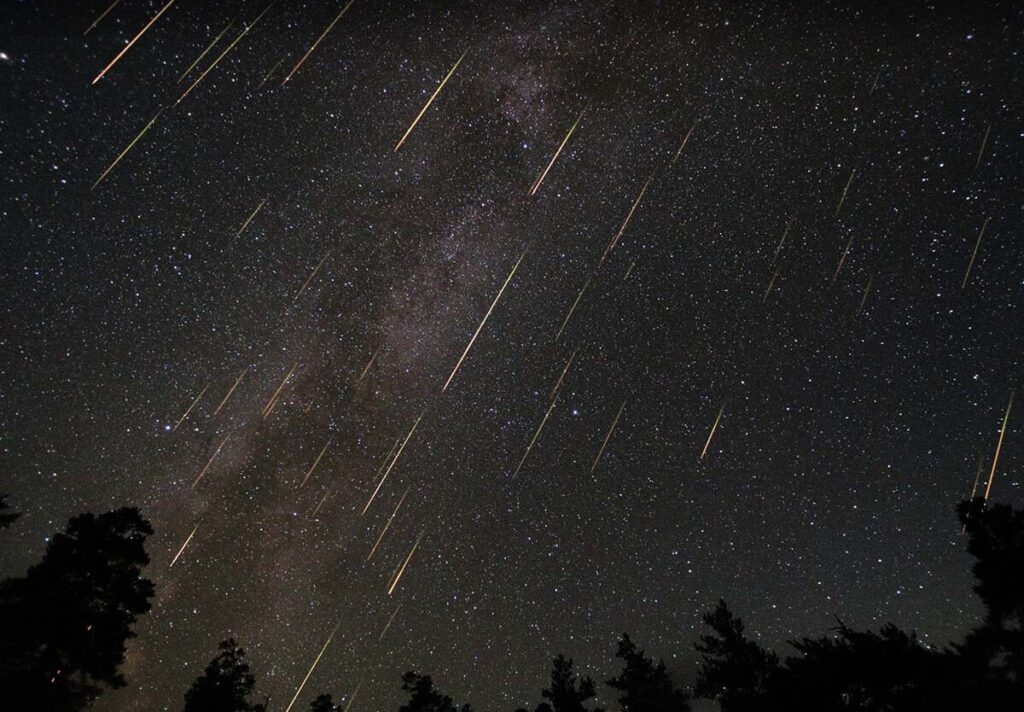The Perseid meteor shower is one of the best shooting star displays of the year.
The Perseid meteor shower (also known as the Perseids) is active every year from mid-July to late August.
The next Perseids shooting star display will peak around the night of Aug. 12 and before dawn on Aug.13, 2024.
Though the moon will be 50% illuminated at the time of the Perseids’ peak, it will set around midnight, so there will be dark skies until dawn — perfect for meteor hunting!
If you didn’t manage to see any Perseids during the 2023 peak or perhaps you just want to see even more, we’ve rounded up some of the best Perseid meteor shower 2023 photos.
2024 should be a good year for the Perseids as although the moon will be 50% illuminated, it will set at midnight, providing dark skies through the wee hours until dawn.
Though the Perseids occur every year, the stage is already set for a potential Perseid meteor storm in 2028, so mark your calendars now!
The Perseids are caused by Earth passing through debris — bits of ice and rock — left behind by Comet Swift-Tuttle which last passed close to Earth in 1992. The Perseids peak when Earth passes through the densest and dustiest area on Aug. 11-12. Years without moonlight see higher rates of meteors per hour, and in outburst years (such as in 2016) the rate can be between 150-200 meteors an hour.
On average, you can expect to see up to 100 meteors per hour during the Perseid’s peak, according to NASA.
In 2023, the Perseids put on a good display as the moon provided minimal disturbance to the meteor shower as it was only 10% illuminated at the time of the peak.
A typical Perseid meteoroid (which is what they’re called while in space) moves at 133,200 mph (214,365 kph) when it hits Earth’s atmosphere (and then they are called meteors). Most of the Perseids are tiny, about the size of a sand grain. Almost none of the fragments hit the ground, but if one does, it’s called a meteorite.
The Perseids are hot stuff, reaching temperatures of more than 3,000 degrees Fahrenheit (1,650 Celsius) as each fragment travels through the atmosphere and both compresses and heats the air in front of it. Most of the fragments are visible when they are about 60 miles (97 kilometers) from the ground.
he Perseid meteor shower is caused by the comet Swift-Tuttle.
Swift-Tuttle was discovered independently by two astronomers, Lewis Swift and Horace Tuttle, in 1862. When it last made a pass by Earth in 1992, it was too faint to be seen with the naked eye. The next pass, in 2126, could make it a naked-eye comet similar in brightness to the 1997 Hale-Bopp comet — providing that predictions are correct.
Comet Swift-Tuttle is the largest object known to repeatedly pass by Earth; its nucleus is about 16 miles (26 kilometers) wide. It last passed near Earth during its orbit around the sun in 1992, and the next time will be in 2126.
When you sit back to watch a meteor shower, you’re actually seeing the pieces of comet debris heat up as they enter the atmosphere and burn up in a bright burst of light, streaking a vivid path across the sky as they travel at 37 miles (59 kilometers) per second, according to NASA.

Meteor showers are named after the constellation from which the meteors appear to emanate. From Earth’s perspective, the Perseids appear to come approximately from the direction of the Northern Hemisphere constellation Perseus.
You can see the Perseid meteor shower best in the Northern Hemisphere and down to the mid-southern latitudes, and all you need to catch the show is darkness, somewhere comfortable to sit and a bit of patience.
To find the Perseid meteor shower, it’s a good idea to look for the point in the sky where they appear to originate from, this is known as the radiant. According to NASA, the Perseids’ radiant is in the Perseus constellation. Though Perseus isn’t the easiest to find, it conveniently follows the brighter and more distinctive constellation Cassiopeia across the night sky. The meteor shower gets its name from the constellation it radiates from, the constellation is not the source of the meteors.
If you take a cool photo of the Perseid meteor shower let us know! You can send images and comments to spacephotos@space.com.
To best see the Perseids, go to the darkest possible location and lean back and relax. You don’t need any telescopes or binoculars as the secret is to take in as much sky as possible and allow about 30 minutes for your eyes to adjust to the dark.
If you want more advice on how to photograph the Perseid meteor shower, check out our how to photograph meteors and meteor showers guide and if you need imaging gear, consider our best cameras for astrophotography and best lenses for astrophotography.
When is the Best Time to View the Perseid Meteor Shower?
The peak viewing days are typically your best shot to see the sky speckled with bright meteors. To see the meteors, look up and to the north. Those in southern latitudes can look toward the northeast to see more meteors.
Skywatchers looking out for the Perseids might also be treated to some stray meteors from the southern delta Aquariid meteor shower which peaks in late July, according to AMS. Though the southern delta Aquariids are best viewed from the Southern Hemisphere, they can sometimes be visible to those in the mid-latitudes in the Northern Hemisphere.
Could Comet Swift-tuttle Collide With Earth?
An astronomer calculating Swift-Tuttle’s orbit once suggested that it could come dangerously close to Earth in 2126 and possibly collide with the planet. Further refinements, however, show that the comet will not, according to a primer by the Astronomical Society of the Pacific.
Swift-Tuttle’s pass by Earth in the year 3044 could bring it within a million miles of our planet. That’s just over twice the distance from the Earth to the moon, making the comet very close in astronomical terms.
The uncertainty came because initial projections for Swift-Tuttle’s path through space came from only three months of observations in the 1860s, when the comet was first discovered, added the primer’s author, Sally Stephens.
In the 1970s, astronomers noted that the number of annual Perseids meteors was increasing, suggesting that the comet would make an appearance soon. “But it failed to show, and soon afterward, Perseid meteor activity dropped sharply. Astronomers wondered if the comet had somehow come and gone unnoticed,” Stephens wrote.
Brian Marsden, who was an astronomer with the Harvard-Smithsonian Center for Astrophysics, suggested in 1973 that Swift-Tuttle might be the same comet as one seen in 1737 by a Jesuit missionary in China.
Marsden suggested the comet would return in 1992, which it did, but its closest approach was 17 days off from his prediction. He continued tweaking his calculations. Although he initially predicted a possible collision in 2126, he examined the historical record and found observations of a comet in a similar track as far back as at least 188 A.D. — allowing him to calculate the comet would pose no harm.
“His new calculations show Comet Swift-Tuttle will pass a comfortable 15 million miles from Earth on its next trip to the inner solar system,” Stephens wrote.
Source: Space


